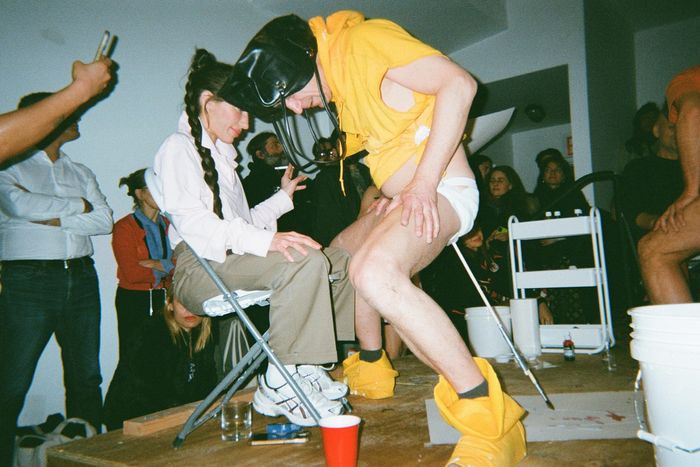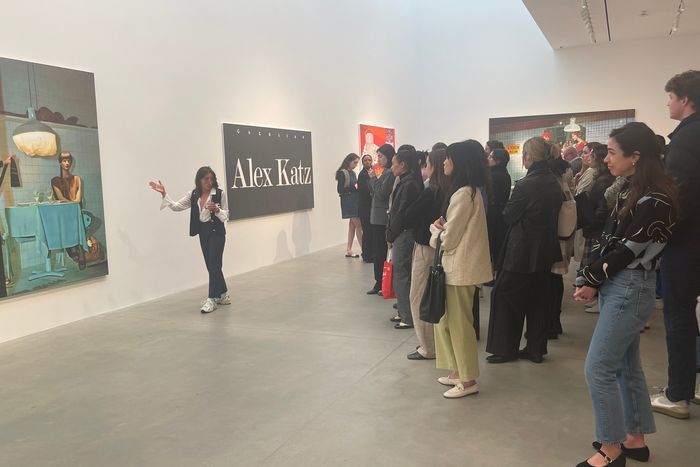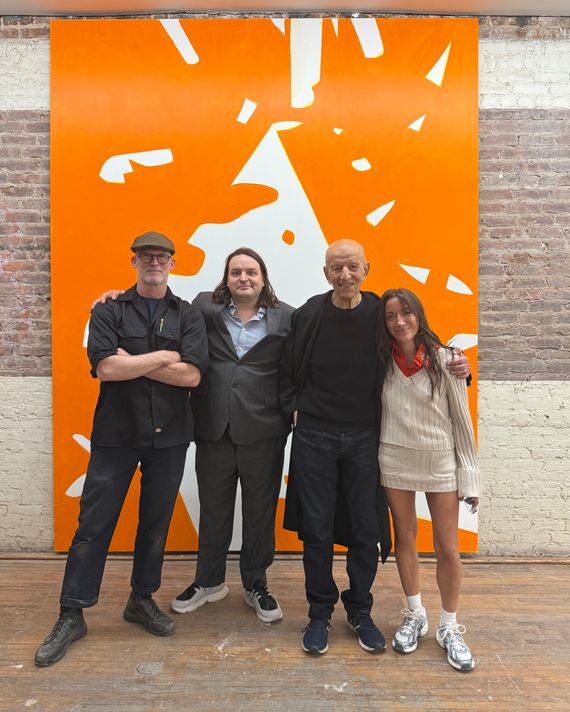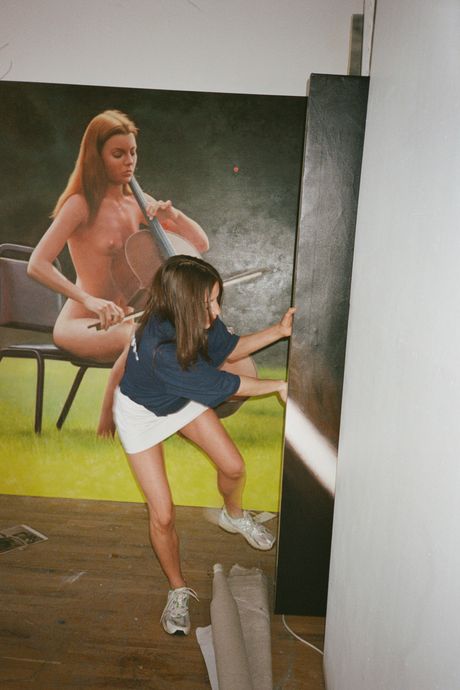This article was featured in One Great Story, New York’s reading recommendation newsletter. Sign up here to get it nightly.
It was St. Patrick’s Day weekend 2024, and it was so crowded inside the Gagosian showroom that had taken over Mary Boone’s old gallery on West 24th Street that I could barely see the paintings. Downtown rats, art-school students, several generations of art stars, musicians, Hypebeast editors, collectors, writers, academics, Harold Ancart, Leo Fitzpatrick (bumming out cigs), Jennifer Lawrence — all there for Jamian Juliano-Villani’s solo show. There was a line down the block. Juliano-Villani, a head shorter than most, entered with “I need a fuckin’ drink!” in her Newport 100’s New Jersey growl. Matt Dillon followed, arm in arm with her mom.
There was art, too: big, expensive (up to $200,000 apiece), ironic oil paintings. A portrait of Henry Kissinger against an I Spy background; another that read STEAMY LITTLE JEWISH PRINCESS with the T’s replaced by the Western Beef cactus. The showstopper was on the front wall: Juliano-Villani, larger than life-size in track pants and ASICS sneakers, staring blankly ahead while squeezing Elvis’s crotch.
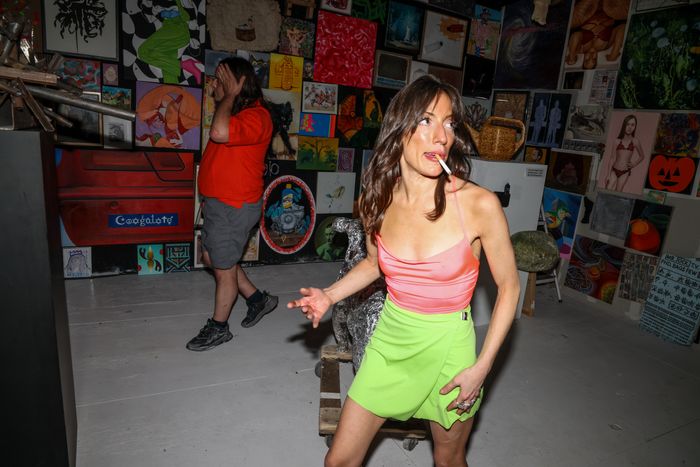
The weekend before the Gagosian exhibit, Juliano-Villani and Grant sat behind their shared desk at O’Flaherty’s discussing strategies with their publicist, Kaitlin Phillips. Grant is five-seven, gentle, nervous, with long and sharp features, beady eyes, black hair parted down the middle, and bad posture. He’s 40 and has lived on Juliano-Villani’s couch on and off over the years; they’re best friends and business partners. She describes their relationship as like Pinky and the Brain; Grant is, I think, the Brain. Through his teens and 20s, he was part of a Virginia Beach artists collective called Dearraindrop, known for its Day-Glo collages; he went on to assist the artist Brian Belott, who introduced him to Juliano-Villani. The first time he went to her house in Bed-Stuy, Juliano-Villani asked him to finish one of her paintings. She left him with it, and when she came back, “It looked like some fucking insane monster of a thing,” she said. “It was out of control. I was like, He’s fucked up just like me.”
Juliano-Villani grew up in suburban New Jersey. Her parents owned a silk-screening factory that made store signs and printed T-shirts for pop bands. Her step-grandfather was a Newark judge, then later the city’s mayor. She was a hustler even as a kid — as a teenager, she held two or three jobs at a time, folding tees at her parents’ factory, chauffeuring kids to snowboarding trips in her beat-up station wagon, and clocking hours at the YMCA. Her twin, Julianna, was the more conventional of the pair, content with Somerset County’s mall-and-lacrosse culture. (Now she lives in Connecticut with four kids.) Jamian was constantly rewiring objects around the house and sketching in a notebook. “We always said, ‘Julianna wears the pearls, but Jamian wears the leather jacket,’” her mother, Michele, told me. Jamian made the varsity cheerleading squad as a freshman, but after being shoved down the stairs by upperclassmen, she didn’t return. Instead, she spent time with Zarsky, a trans musician and painter who introduced her to the punk scene. “I took her under my wing,” Zarsky said. “It was just, like, a gut instinct in me. I had to shepherd her because I believed there was greatness there.” Art school was Juliano-Villani’s calling, and like any true hustler, she took a shortcut — borrowing some of Zarsky’s portfolio to get a full scholarship at Pratt. Her parents successfully pushed for Rutgers instead, reminding Juliano-Villani that “one day you’ll have to pay car insurance.”
On the last day of her Gagosian show, April 20, I stopped by to meet Juliano-Villani for a private tour. A crew of slick and angular Gagosian publicists and gallerists met me at the front desk, offering cappuccinos. “Let’s smoke a cigarette,” Juliano-Villani said, so we slipped outside. People trickled in, trying to catch a final glimpse. Before we went back in, she changed her mind about the tour entirely. “Let’s do this next week,” she said. The following Wednesday, we came back without the public, just the two of us amid her work. She’s in gold frames with clear lenses, an oversize brown V-neck sweater, a crisp white popped collar half-tucked into jeans, and platform running shoes. If the paintings have anything in common, it’s their deliberate flatness, a feeling that they could all be hanging above the bed in a no-name roadside inn. In front of the painting of I Spy Henry Kissinger, she said, “I’m thinking cinematically. They all exist as one painting. But I hate having a style. I have to make this shit to make the other shit. I need this all to sell for O’Flaherty’s to survive so the party can continue.” The reviews for the show had been mixed, but the pieces apparently sold well, reportedly in the five and six figures. She sprawled out on the front desk in a power pose. “It’s supply, but it’s demand too, motherfucker,” she said to me.
A few weeks later, the landlord let Juliano-Villani out of her lease on the UCB space. She had to scramble to close shop. She showed me photos on her phone of a building on Allen Street, a potential new O’Flaherty’s space, a former restaurant. “Probably full of asbestos,” she said. She didn’t care. “Enter at your own risk. I’m willing to die for this shit, motherfuckers.” We walked down Avenue A, passing the first O’Flaherty’s. “Spent almost six figures just storing Donna Dennis’s installation,” she said. “Billy threw out his back disassembling it.” We turned the corner on Stanton and found Grant on a sidewalk bench drinking Coronas. Juliano-Villani rattled off her upcoming shows: “Italy, London, and Gagosian wants something in Paris.” Her voice dropped. “Haven’t even started the work. It’s all a mess.” She was hyperfocused on doing a drawing show, and now she was looking at a boat in Connecticut; the idea was to stick a single pencil on it and call that a drawing. “Probably need a cabin boy,” she said, thinking out loud. “Gotta find someone who’ll live on the boat for free just to keep an eye on it.” It won’t be Grant — he told me he’s finally got his own apartment, a Williamsburg sublet he hopes to keep. “Feels great,” he said, lighting up a Newport. “I got a bed. First one in years. I’ve never lived alone before.”
Two days after Trump was elected, the show happened in O’Flaherty’s new space on Allen Street. I arrived early. It had been cleaned up since I saw the pictures; it was so white-walled and spare that if you squinted, it could be any blue-chip gallery — 52 Walker or even Gagosian. Behind the bar of the former restaurant, flat screens flickered with Barney’s video installation chronicling Katz at work. In them, the 97-year-old artist mixes paint and teeters up a ladder to his canvases. Upstairs, the actual Alex Katz stood in front of the Nickelodeon-orange abstract paintings he is creating in the videos. Gagosian surveyed the scene and shook hands with Barney. “Great work,” he said, and slipped out. The rest of us went out to the backyard. Grant wore a sharp suit; he seemed content. I asked Juliano-Villani if she wanted to hit the joint, but she declined. “I’ve gotta be professional,” she said. She glanced at the security guards standing at attention in various corners, wearing earpieces. Later, Klaus Biesenbach would show up. So would Mel Ottenberg. As if she were reminding herself this is still O’Flaherty’s — whatever that means anymore — Juliano-Villani stormed up to the sentinel she hired. “By the way, you can smoke in here,” she said. “Trust me, things are about to get crazy here.” But would it? Juliano-Villani turned to Grant. “How many years did we lose putting this on, Billy?” she asked him, referring to the black mold they cleared out of the place. “At least a few,” Grant said. “But I like it here. This place is Zen as fuck,” Juliano-Villani said, smoking a cigarette and surrounded by the yellow leaves of the stagnated fall. I began to ask what this show was all about, but before I could finish, she handed me the press release that Grant wrote and that she’d been reading over and over: “O’Flaherty’s is pleased to present ‘The Bitch,’ an exercise in their master craft. In the end, the work gets all the glory. The bitch is just the plan, and mostly gets all the blame.”
